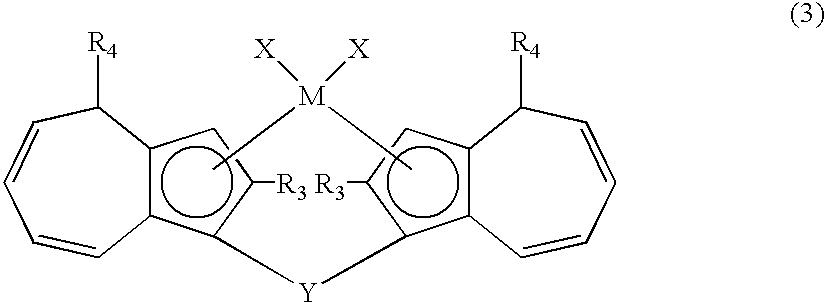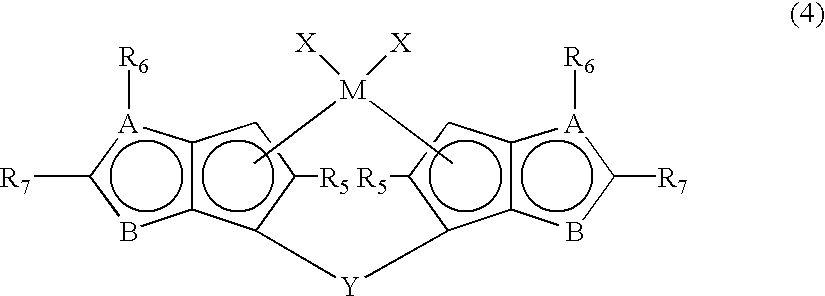Metallocene compounds, production process for olefin polymers using catalysts containing them and olefin polymers produced by the production process
- Summary
- Abstract
- Description
- Claims
- Application Information
AI Technical Summary
Benefits of technology
Problems solved by technology
Method used
Image
Examples
example 1
Synthesis of rac-dimethylsilylenebis(2-(2-(5-methyl)-furyl)-4-phenyl-indenyl)zirconium dichloride
(1) Synthesis of dimethylbis(2-(2-(5-methyl)-furyl)-4-phenyl-indenyl)silane
[0234]After adding 12 g (0.045 mol) of 2-(2-(5-methyl)-furyl)-4-phenyl-indene, 0.3 g (2.5 mmol) of copper isocyanate and 150 ml of tetrahydrofuran to a 200 ml glass reactor, the mixture was cooled to −70° C. in a dry ice / methanol bath. Next, 30 ml (0.045 mol) of a 1.50 mol / L n-butyllithium / hexane solution was added dropwise thereto. After the dropwise addition, the mixture was stirred for 16 hours while gradually returning it to room temperature. It was again cooled to −50° C. in a dry ice / methanol bath, and 40 ml of a tetrahydrofuran solution containing 2.9 g (0.022 mol) of dimethyldichlorosilane was added dropwise. After the dropwise addition, the mixture was stirred for 16 hours while gradually returning it to room temperature.
[0235]Distilled water was added to the reaction solution which was then transferred t...
example 2
Production of Preactivated Supported Metallocene Catalyst
(1) Production of Supported Metallocene Catalyst
[0240]After loading 89 ml (267 mmol in terms of Al atoms) of a toluene solution containing methylaluminoxane (concentration: 3 mol / liter; “PMAO”, product of Tosoh Akzo Co., Ltd.) and 0.929 millimoles of the dimethylsilylenebis(2-(2-(5-methyl)-furyl)-4-phenyl-indenyl) zirconium dichloride racemate synthesized in Example 1 as a metallocene compound into a nitrogen gas-substituted stirrer-equipped glass reactor with an inner volume of 500 ml, the mixture was stirred and kept at 25° C. for 15 minutes for reaction to obtain the reaction product of the metallocene compound and aluminoxane, i.e. a metallocene catalyst. Next, 6.7 g of silica with a mean particle size of 51 μm (“SYLOPOL(R) 948”, product of Grace Davison Co.) which had been calcined for 8 hours at a temperature of 750° C. under reduced pressure was loaded into the reactor, the temperature of the reactor was raised to 110° ...
example 3
Production of propylene homopolymer using rac-dimethylsilylenebis (2-(2-(5-methyl)-furyl)-4-phenyl-indenyl) zirconium dichloride as catalyst component
[0247]After adding a methylaluminoxane / toluene solution (“MMAO3A”, product of Tosoh Akzo) to an SUS autoclave at 4.5×10−3 mol in terms of Al, 1 L of liquefied propylene was added and the temperature was raised to 50° C. Separately, the dimethylsilylenebis(2-(2-(5-methyl)-furyl)-4-phenyl-indenyl) zirconium dichloride racemate synthesized in Example 1 (0.20×10−6 mol) and a methylaluminoxane / toluene solution (“MMAO3A”, product of Tosoh Akzo) (3.0×10−3 mol in terms of Al) were reacted for 15 minutes, after which the reaction solution was injected into an autoclave to initiate polymerization reaction for propylene homopolymerization at 50° C. for 20 minutes. The polymerization reaction was suspended by addition of a small amount of methanol, and then the product was delimed with a strong alkali solution and dried to obtain 23.2 g of a propy...
PUM
 Login to View More
Login to View More Abstract
Description
Claims
Application Information
 Login to View More
Login to View More - R&D
- Intellectual Property
- Life Sciences
- Materials
- Tech Scout
- Unparalleled Data Quality
- Higher Quality Content
- 60% Fewer Hallucinations
Browse by: Latest US Patents, China's latest patents, Technical Efficacy Thesaurus, Application Domain, Technology Topic, Popular Technical Reports.
© 2025 PatSnap. All rights reserved.Legal|Privacy policy|Modern Slavery Act Transparency Statement|Sitemap|About US| Contact US: help@patsnap.com



